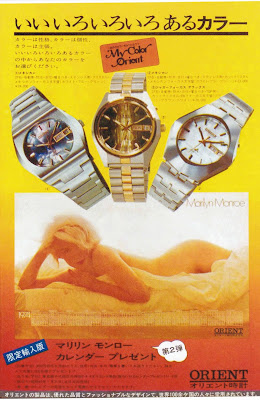In 1970 Orient presented the Jaguar Focus dial, its own contribution to the growing global trend of colorful watches. A couple of years had passed and someone over at Orient's design department obviously figured that simple gradient painting was not enough, and came up with the Mexican Focus dial, or simply – "Mexican".
Why was it called Mexican? I've seen a few theories. The most probable
one is that Orient used colorful Mother-of-Pearl that was made to resemble
Mexican Opal, a shiny and vibrant gemstone that can in its top form be very expensive
(way more than MoP). Another theory, is that was simply made from Mexican MoP,
which can be produced from the Pinctada Mazatlanica oyster.
I actually found references to both theories in descriptions of Orient
Mexican models… Anyway, here is the first Orient Chronoace Mexican model from
1972, along with some Mexican MoP and some Mexican Opals. You can make up your own
mind on this question. Maybe it's just Mopal…
Whether the intention was to resemble opal or simply to boast the
natural beauty of mother-of-pearl itself, the material used was certainly MoP.
A few words on this substance perhaps… Mother-of-Pearl is the iridescent
lining of the inner shell of some mollusks. When a foreign substance, such as a
grain of sand, gets inside the mollusk's shell, it can be an irritant. To
protect itself, the mollusk secretes a smooth, crystalline substance called
nacre around the irritant. Over time, as layers of nacre are added, a pearl can
form. The inner shell, which is lined with this same nacre, acts as a kind of
"mother" to the pearl. Thus, the name "Mother-of-Pearl"
suggests that this material is the source or "mother" from which
pearls are born.
Most Mexican models were Chronoace, that is – day-date models equipped
with variants of Orient's caliber 42. The most popular dial colors were green
and blue; some models also featured silvery dials, and a few dials showed a bit
of purple and violet.
In addition to the Chronoace, which was generally a men's watch, Orient
produced ladies' Mexican models as well. Such were the Mexican Minimatic,
Chamade and Selene.
Watches boasting the "Mexican" dial were priced considerably higher
than their standard counterparts. For instance – A Chronoace costing around
17,000 JPY at the time, would have been closer to 22,000 JPY with a Mexican
dial.
The same was true for the ladies' watches. A Mexican Minimatic would
have cost 15,000 JPY compared to a similar regular Minimatic costing 12,000
JPY. A similar 3,000 JPY premium would have been charged for Mexican versions
of the Chamade and Selene models.
There was even a top-of-the-line Chronoace that combined a non-scratch
case and MoP dial (you can see its picture in the related article). I'm not
sure what price tag was attached to this baby, but it must have been quite
high!
I have also seen other watches being referred to as "Mexican"
in sale ads and posts. For instance, I
saw "Orient Crystal Mexican" and "AAA Mexican". However, I
did not see any official catalogs that used that verbiage, which leads me to
think that possibly, some sellers have adopted the term "Mexican" to
any vintage Orient with a MoP dial.
Indeed MoP remains a popular material for Orient in adorning some of its
high-end models, like some recent Orient
Star releases. Needless to say, not all that glitters is Mexican!







